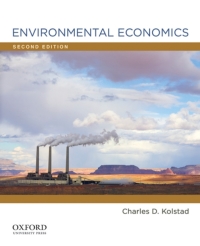Consider the model of a voluntary environmental agreement, in which there is a firm, a regulator, and
Question:
Consider the model of a voluntary environmental agreement, in which there is a firm, a regulator, and a legislature. Benefits of abatement (in terms of reduced damage from pollution) are given by \(B(a)=100 a-a^{2} / 2\). The total costs of abatement under the mandatory regime are \(c_{\mathrm{m}}(a)=20 a\), and under the voluntary regime they are \(c_{x}(a)=10 a\). In the event that no voluntary agreement is made, assume that the legislature acts with the optimal mandatory policy with probability \(p=0.5\). Your task is to determine whether \(a_{v}=80\) is an implementable voluntary agreement, and, if so, to determine its efficiency benefits to society in comparison to two different counterfactuals:
(a) no-environmental protection, and
(b) successful mandatory regulation.
Step by Step Answer:






